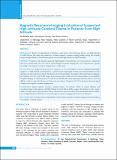Please use this identifier to cite or link to this item:
https://hdl.handle.net/20.500.14356/890| Title: | Magnetic Resonance Imaging Evaluation of Suspected High-Altitude Cerebral Edema in Patients from High Altitude |
| Authors: | Karki, Dan Bahadur Gurung, Ghanashyam Ghimire, Ram Kumar |
| Citation: | KarkiD. B., GurungG., & GhimireR. K. (2022). Magnetic Resonance Imaging Evaluation of Suspected High-Altitude Cerebral Edema in Patients from High Altitude. Journal of Nepal Health Research Council, 20(02), 354-360. https://doi.org/10.33314/jnhrc.v20i02.3944 |
| Issue Date: | 2022 |
| Publisher: | Nepal Health Research Council |
| Keywords: | Acute mountain sickness High altitude cerebral edem Magnetic resonance imaging Microhemorrhage Susceptibility weighted imaging |
| Series/Report no.: | April-June, 2022;3944 |
| Abstract: | Abstract Background: Trekkers in high altitude of Himalayas could lead to Acute Mountain Sickness and High Altitude Cerebral Edema. This study was conducted to evaluate magnetic resonance imaging findings among the clinically suspected High Altitude Cerebral Edema patients rescued from high altitudes in Nepal Himalayas. Methods: 49 patients with clinically suspected High Altitude Cerebral Edema were retrospectively evaluated in this cross-sectional study who were sent for a brain magnetic resonance imaging. They were categorized in 3 groups according to the magnetic resonance imaging features in this study. Results: There was a slight male preponderance. 6 patients (12.25%) had magnetic resonance imaging findings highly suggestive of High Altitude Cerebral Edema. 5 patients had T2 high signal intensity and restricted diffusion in the splenium of corpus callosum of which 3 had features of microhemorrhage. One patient with normal brain morphology and intensity in T1, T2, and FLAIR images showed innumerable variable-sized microhemorrhages in Susceptibility Weighted Imaging. 14 of patients showed various T2 and FLAIR white matter high signal intensity without restricted diffusion. And one patient had features of subacute lacunar infarcts. 28 patients (57.14 %) showed no abnormal signal changes in the magnetic resonance imaging scan. Conclusions: Typical magnetic resonance imaging features of cytotoxic edema in corpus callosum and microhemorrhage in the patients with High Altitude Cerebral Edema further support the findings in other similar studies. T2 white matter hyperintensities in deep, subcortical or periventricular location and lacunar infarcts could be seen in High Altitude Cerebral Edema. Normal magnetic resonance imaging of the brain is not infrequent. Keywords: Acute mountain sickness; high altitude cerebral edema; magnetic resonance imaging; microhemorrhage; susceptibility weighted imaging |
| Description: | Original Article |
| URI: | http://103.69.126.140:8080/handle/20.500.14356/890 |
| ISSN: | Print ISSN: 1727-5482; Online ISSN: 1999-6217 |
| Appears in Collections: | Vol 20 No 02 Issue 55 April-June, 2022 |
Files in This Item:
| File | Description | Size | Format | |
|---|---|---|---|---|
| 3944-Manuscript-29679-1-10-20221103.pdf | Full Article. | 715.62 kB | Adobe PDF |  View/Open |
Items in DSpace are protected by copyright, with all rights reserved, unless otherwise indicated.
